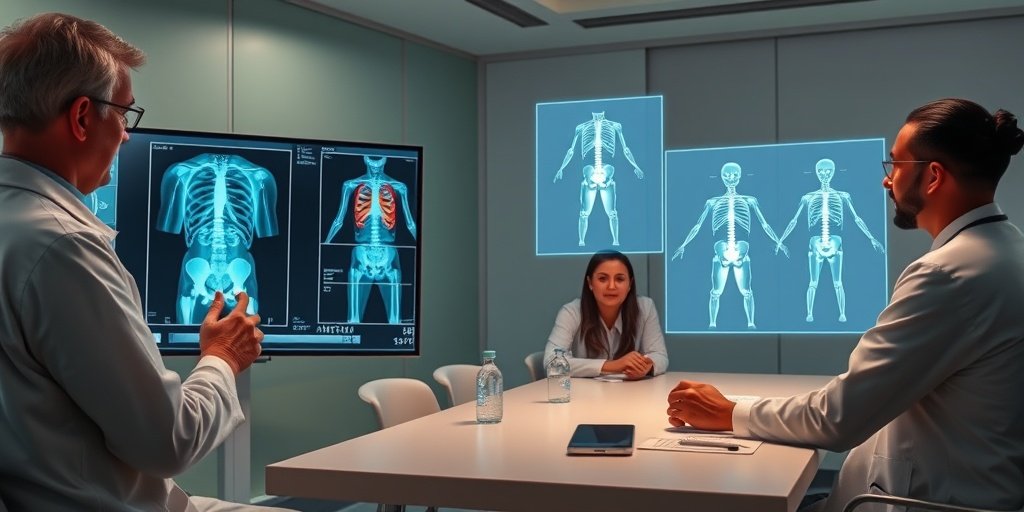⚡ Quick Summary
A recent global survey revealed that a significant majority of healthcare professionals are open to integrating image recognition artificial intelligence (AI) into the diagnostic workflow for rare bone diseases (RBDs). Despite concerns regarding AI-related errors, 81% of respondents expressed willingness to adopt this technology to enhance diagnostic accuracy.
🔍 Key Details
- 🌍 Participants: 103 healthcare professionals from 27 countries
- 👩⚕️ Respondent Profile: Primarily physicians (89%), mainly from academic medical centers (81%)
- 🧬 Specialties: Medical geneticists, pediatricians, and endocrinologists (69% of respondents)
- 📸 Imaging Importance: 91% consider imaging very or extremely important, with X-rays being the preferred modality
🔑 Key Takeaways
- 🤖 AI Integration: 81% of respondents are likely to consider AI in their diagnostic workflows.
- ⚠️ Concerns: 45 participants expressed concerns about AI-related errors and the need for explainability.
- 📈 Imaging Preference: X-rays are viewed as the most critical imaging modality for diagnosing RBDs.
- 🌐 Global Reach: The survey included responses from diverse regions, predominantly Europe, the US, and Canada.
- 🔍 Diagnostic Challenges: RBDs are complex due to their rarity and heterogeneity, making timely diagnosis essential.

📚 Background
Rare bone diseases (RBDs) encompass a wide range of conditions characterized by abnormalities in bone and cartilage. The individual rarity and diverse nature of these diseases pose significant challenges for accurate and timely diagnosis. Establishing correlations between genotype and phenotype, primarily through imaging techniques, is crucial for effective diagnosis. The advent of image recognition AI offers a promising avenue to enhance diagnostic accuracy and efficiency in this field.
🗒️ Study
Conducted from March to September 2024, this survey aimed to gauge the interest of healthcare professionals worldwide in utilizing AI-based tools for the differential diagnosis of RBDs. The survey was disseminated through various channels, including direct emails, newsletters, and flyers at scientific conferences, ensuring a broad reach across different regions and specialties.
📈 Results
The survey garnered responses from 103 healthcare professionals, with a notable representation from Europe, the United States, and Canada. A striking 91% of participants emphasized the importance of imaging in diagnosing RBDs, with X-rays being the most favored modality. While concerns about AI-related errors were prevalent, a significant 81% of respondents indicated a willingness to integrate AI into their diagnostic practices, highlighting a positive outlook towards technological advancements in healthcare.
🌍 Impact and Implications
The findings of this survey underscore the potential for image recognition AI to transform the diagnostic landscape for rare bone diseases. By assisting healthcare professionals in identifying and differentiating imaging patterns, AI can enhance diagnostic accuracy and reduce the time to diagnosis. However, the concerns regarding AI-related errors and the need for transparency in AI algorithms must be addressed to foster trust and ensure practical adoption in clinical settings.
🔮 Conclusion
This survey highlights the readiness of healthcare professionals to embrace AI technologies in diagnosing rare bone diseases, despite existing concerns. The integration of AI into diagnostic workflows could significantly improve patient outcomes by facilitating timely and accurate diagnoses. Continued collaboration between AI developers and healthcare professionals is essential to create trustworthy and clinically applicable AI solutions. The future of RBD diagnosis looks promising with the potential of AI at the forefront!
💬 Your comments
What are your thoughts on the integration of AI in diagnosing rare bone diseases? We invite you to share your insights and engage in a discussion! 💬 Leave your comments below or connect with us on social media:
Artificial intelligence for diagnosing rare bone diseases: a global survey of healthcare professionals.
Abstract
BACKGROUND: Rare bone diseases (RBDs) are an important group of conditions characterized by abnormalities in bone and cartilage. Their large number, individual rarity, and heterogeneity make accurate and timely diagnosis challenging. Establishing correlations between genotype and phenotype (mainly via imaging) is critical for diagnosing RBDs. Image recognition artificial intelligence (AI) has the potential to significantly improve the diagnostic process by assisting healthcare providers to identify and differentiate imaging patterns associated with various RBDs. This survey study sought to assess the interest of various healthcare providers worldwide in utilizing an AI-based assistant tool for the differential diagnosis of RBDs.
METHOD: Survey data were collected from March to September 2024. The survey was performed online and the link was disseminated via direct email, newsletters, and flyers at scientific talks and conferences.
RESULTS: We received 103 completed surveys, representing respondents from 27 different countries covering most global regions, but mostly from Europe, the United States, and Canada. The majority of the participants are physicians (n = 92, 89%) and primarily work at academic medical centers (n = 84, 81%). While each participant could select multiple specialties, the most frequent clinician types were medical geneticists, pediatricians, and endocrinologists, accounting for 71 (69%) of the respondents. Ninety-four (91%) of the respondents find imaging to be very or extremely important, and the majority (n = 84, 81%) consider X-rays to be the most important imaging modality. Although around half of the participants (n = 45) have concerns about AI-related errors and consider the explainability of AI algorithms to be very (42/103) or extremely (9/103) important, 81% of the respondents report that they are somewhat (n = 39) or extremely (n = 45) likely to consider integrating image recognition AI into their current diagnostic workflow.
CONCLUSIONS: Most survey participants are open to integrating image recognition AI into their RBD diagnostic workflow. However, concerns about AI-related errors, privacy, and model interpretability highlight the importance of transparent collaboration between developers and healthcare professionals throughout the development process to ensure that such technologies are clinically trustworthy and practically adoptable.
Author: [‘Javanmardi B’, ‘Waikel RL’, ‘Tkemaladze T’, ‘Moosa S’, ‘Küsshauer A’, ‘Pantel JT’, ‘Fardipour M’, ‘Krawitz P’, ‘Solomon BD’, ‘Mohnike K’]
Journal: Orphanet J Rare Dis
Citation: Javanmardi B, et al. Artificial intelligence for diagnosing rare bone diseases: a global survey of healthcare professionals. Artificial intelligence for diagnosing rare bone diseases: a global survey of healthcare professionals. 2025; 20:365. doi: 10.1186/s13023-025-03875-1